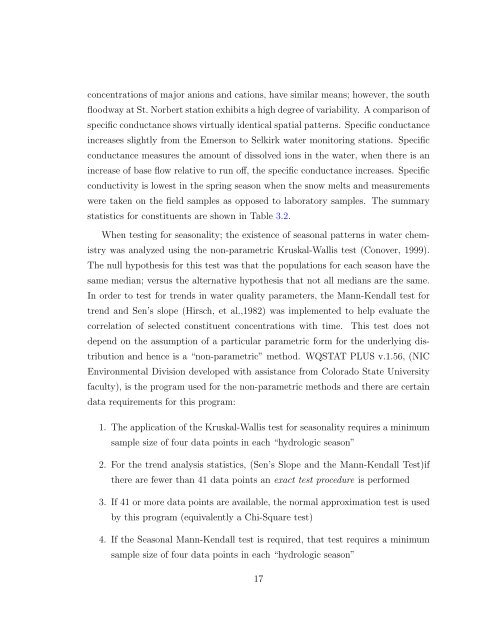Statistical Analysis of Trends in the Red River Over a 45 Year Period
Statistical Analysis of Trends in the Red River Over a 45 Year Period
Statistical Analysis of Trends in the Red River Over a 45 Year Period
You also want an ePaper? Increase the reach of your titles
YUMPU automatically turns print PDFs into web optimized ePapers that Google loves.
concentrations <strong>of</strong> major anions and cations, have similar means; however, <strong>the</strong> south<br />
floodway at St. Norbert station exhibits a high degree <strong>of</strong> variability. A comparison <strong>of</strong><br />
specific conductance shows virtually identical spatial patterns. Specific conductance<br />
<strong>in</strong>creases slightly from <strong>the</strong> Emerson to Selkirk water monitor<strong>in</strong>g stations. Specific<br />
conductance measures <strong>the</strong> amount <strong>of</strong> dissolved ions <strong>in</strong> <strong>the</strong> water, when <strong>the</strong>re is an<br />
<strong>in</strong>crease <strong>of</strong> base flow relative to run <strong>of</strong>f, <strong>the</strong> specific conductance <strong>in</strong>creases. Specific<br />
conductivity is lowest <strong>in</strong> <strong>the</strong> spr<strong>in</strong>g season when <strong>the</strong> snow melts and measurements<br />
were taken on <strong>the</strong> field samples as opposed to laboratory samples. The summary<br />
statistics for constituents are shown <strong>in</strong> Table 3.2.<br />
When test<strong>in</strong>g for seasonality; <strong>the</strong> existence <strong>of</strong> seasonal patterns <strong>in</strong> water chemistry<br />
was analyzed us<strong>in</strong>g <strong>the</strong> non-parametric Kruskal-Wallis test (Conover, 1999).<br />
The null hypo<strong>the</strong>sis for this test was that <strong>the</strong> populations for each season have <strong>the</strong><br />
same median; versus <strong>the</strong> alternative hypo<strong>the</strong>sis that not all medians are <strong>the</strong> same.<br />
In order to test for trends <strong>in</strong> water quality parameters, <strong>the</strong> Mann-Kendall test for<br />
trend and Sen’s slope (Hirsch, et al.,1982) was implemented to help evaluate <strong>the</strong><br />
correlation <strong>of</strong> selected constituent concentrations with time. This test does not<br />
depend on <strong>the</strong> assumption <strong>of</strong> a particular parametric form for <strong>the</strong> underly<strong>in</strong>g distribution<br />
and hence is a “non-parametric” method. WQSTAT PLUS v.1.56, (NIC<br />
Environmental Division developed with assistance from Colorado State University<br />
faculty), is <strong>the</strong> program used for <strong>the</strong> non-parametric methods and <strong>the</strong>re are certa<strong>in</strong><br />
data requirements for this program:<br />
1. The application <strong>of</strong> <strong>the</strong> Kruskal-Wallis test for seasonality requires a m<strong>in</strong>imum<br />
sample size <strong>of</strong> four data po<strong>in</strong>ts <strong>in</strong> each “hydrologic season”<br />
2. For <strong>the</strong> trend analysis statistics, (Sen’s Slope and <strong>the</strong> Mann-Kendall Test)if<br />
<strong>the</strong>re are fewer than 41 data po<strong>in</strong>ts an exact test procedure is performed<br />
3. If 41 or more data po<strong>in</strong>ts are available, <strong>the</strong> normal approximation test is used<br />
by this program (equivalently a Chi-Square test)<br />
4. If <strong>the</strong> Seasonal Mann-Kendall test is required, that test requires a m<strong>in</strong>imum<br />
sample size <strong>of</strong> four data po<strong>in</strong>ts <strong>in</strong> each “hydrologic season”<br />
17
















